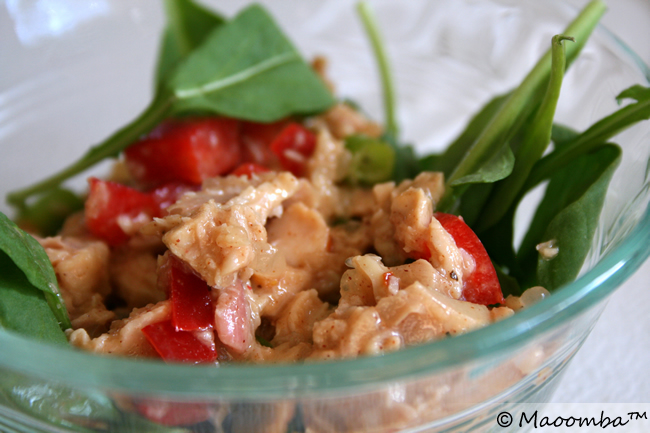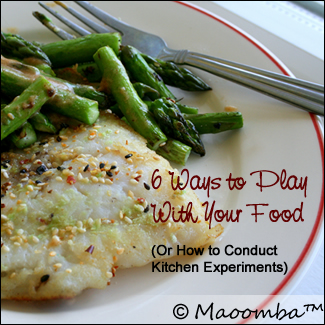Last week, I posted a picture on Facebook and Google+ of a dish I improvised with some roast chicken and other ingredients I had on hand.

Shredded roast chicken with pomelo pieces, unsweetened coconut flakes, red peppers, green onions, and minced garlic. A dressing of almond butter, chili flakes, coconut aminos and fish sauce. Arugula as a base.
It turned out to be an incredibly popular post on Google+, with more comments and sharing than I typically get.
In reading through people’s comments, a few things stood out:
- People love interesting flavors.
- The way food looks is often as important as the way it tastes.
- Experimentation is fascinating!
One person’s take: “if experiments were not done on food, we would not have such a vast diversity found in different food across the world today.”
And, boy, do I love that diversity. Though I was a picky eater as a kid, cooking experimentation and improvisation – and a learned tendency towards adventurous eating – have led me to some amazing discoveries about myself and the foods I now eat. These discoveries are for another day, though.
Cooking Improvisations vs. Experiments
So what’s the difference between cooking improvisation and experimentation, you might be asking yourself? Here are the definitions and my interpretation of them:
| im · pro · viseverb /ˈimprəˌvīz/To make do with whatever materials are at hand orinvent with little or no preparation. Also, devise, contrive, make do, concoct, throw together.In other words, no plan or prep; just pulling fridge finds together in a way that you think will taste good right now without worrying whether you’ll want to recreate it later. | ex · per · i · mentverb /ikˈsperəˌment/Try out new concepts or different ways of doing things (as in order to gain experience). A methodical trial and error procedure to discover, test, or verify something.In other words, taking a more structured and intentional approach to trying new flavors and combinations so that you can make recipe improvements or use ingredients more confidently over time. |
The thai-style chicken salad was an improvisation. I had no idea how it would turn out and whether it would be worth repeating – at the time I didn’t really care. We were hungry and I just happened to have some ingredients that, based on prior experience, I thought would combine well together and taste good. (The truth is, it was too much of a good thing. I would definitely simplify it next time and remove a couple of the ingredients.)
When I have more time, want to test out a recipe, perfect one I’d like to share, or even try unfamiliar ingredients and flavor combinations, I perform kitchen experiments. I am deliberate about what I’m doing, taking notes, paying attention to flavors, smells, and amounts.
In my opinion, conducting experiments makes improvisation easier (because you gain familiarity with what works or doesn’t) and the results of cooking are more likely to turn out well.
 6 Ways to Play With Your Food (Or How to Conduct Kitchen Experiments)
6 Ways to Play With Your Food (Or How to Conduct Kitchen Experiments)
Here are half a dozen ways to experiment – or play – in the kitchen that can help you fine-tune your tasting skills and improve your improvisational cooking abilities:
Sample things when you can. Did you know that many people who work in the produce section of local grocery stores and markets, as well as the people who sell their produce at farmers markets, are often very willing to cut a piece of fruit – and maybe even a vegetable – for you to taste? Sometimes, free samples of other foods are offered. Take advantage of these experiences to learn how unfamiliar foods taste to you before you buy them. What did you like? What didn’t you like?
Get to know your ingredients well. People who can eat a meal and tell you what’s in it, aren’t born knowing what things taste like. Sure, some people have exceptional sensory perception, but, generally speaking, they have also spent time becoming familiar with ingredients and are intentional about doing so. Fortunately, that means, we can be to. It is through this study of ingredients that you can begin to cultivate your palate and discern particular flavors in your food.
- Smell them, taste them, combine them, see how they react when you cook them – how the texture, tastes, and smells change… Open up your spice rack and crack open those bottles – sniff them, spoon out a bit to taste. Become one of those people who has to smell and touch all the produce.
- Compare different types of the same food – like dark to light honey, green to black cardamom, Tahitian vanilla to Madagascan vanilla, store-bought tomatoes to garden-fresh heirlooms – to see what differences you notice. Eating a variety of similar, but different, ingredients is one of the best ways to notice unique aspects of foods – how their colors, textures, flavors, aromas, etc. vary. Have fun while you’re doing this by throwing a tasting party – compare notes with each other!
- Combine ingredients to get a sense of how they taste together; look to different cuisines to learn typical combinations of spices, herbs, and other foods. Sometimes combinations are out of this world; sometimes they’ll make you – for lack of a better term – gag.
- Savor your food; really pay attention to what you are eating and put your sense to work – what do you notice, how do you feel?
Take a cooking class or read regional cook books. Become familiar with cooking techniques and how flavors are combined and ingredients used across different cuisines. See what quantities and amounts are recommended. Doing this gives you a foundation and well-tested structure upon which you can improvise and express your own cooking creativity.
A resource I often refer to when experimenting – and improvising – is The Flavor Bible.
Take notes and tweak recipes.
- Take tasting notes – what do particular ingredients taste like to you, what do you like to combine them with, what do you use them in’
- Keep a record of your cooking experiments – what ingredients, which amounts, how you prepared them, what worked or didn’t, how you’d improve it next time.
- Jot down recipe ideas when you eat out at a restaurant or during your travels. Look to the menu for the main ingredients and work to develop your own version from there.
- Stay open to feedback and be willing to adjust your recipes until they are perfect for you and throwing them together becomes second nature. Then let the improve fun begin!
Be cautious about when you make an experiment to share with others. Not all experiments are equal. Some are meant to be shared – when you have a forgiving bunch of dining companions that know that a recipe could be good or bad. Other experiments should not be shared untested – particularly when an event hinges on the food. I tried a new recipe with several adjustments for a recent dinner party. The recipe did not turn out. At. All! In fact, it was hard as rock on one side/soggy on the other, looked odd when we cut into it, and tasted like furniture polish. While we had a good laugh over it, I realized – in this case – that I should have stuck to what I knew would work.
Make small batches in case something goes horribly wrong. This will help you minimize waste in case what you make does not taste good. Unfortunately, the fish sauce, something I like in cooked foods, made the cold chicken salad dish overly-fishy. We ate less than I expected us too.